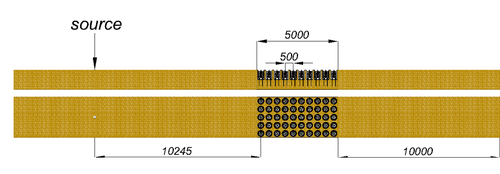The key element of the metabarrier is the resonator. A very preliminary design of the resonator considers a homogeneous soil with shear bulk speed of 150 m/s and a mass density of 1500 kg/m3. The resonator consists of a PVC pipe (diameter 400 mm and height 600 mm), a 10 mm thick circular steel plate of 380 mm diameter, 4 linear elastic springs, and a circular steel plate with diameter 300 mm and thickness 10 mm. The resonators will be buried below the soil surface (their base placed at 600 mm depth) and arranged in a regular square grid of 5 x 10 spaced apart 0.5 meters (see Figures in the presentation). The mass of the resonator can be varied by adding circular concrete disks of approximately 16 kg each. This preliminary design should provide a surface wave attenuation within 50 and 55 Hz, well above the frequencies of the seismic action, with a limited overall experimental cost. In addition, higher frequencies involve smaller Rayleigh wavelengths and thus reduce the risk of having a soil stiffness variability on the considered layer.
The modular resonator design allows realizing metabarriers with different resonant frequencies (even once the resonators are in place). The resonant frequency of each resonator, once buried in the ground, will be evaluated to account also for the soil-structure-interaction (SSI) which should slightly lower the nominal resonant frequency. To this purpose, an operator can simply activate the resonator mass with a soft hammer stroke and record its motion with a single axis (vertical) accelerometer positioned on the top of the mass. Adjustments of the resonator frequency are achievable by varying the compaction of the soil below the resonator base, or varying the number/stiffness of some/all springs.
The modular design of the resonator is also meant to allow building metabarriers characterized by lines of resonators with different resonant frequencies. This, in alignment with the rainbow trapping concept, could open larger band gaps.
